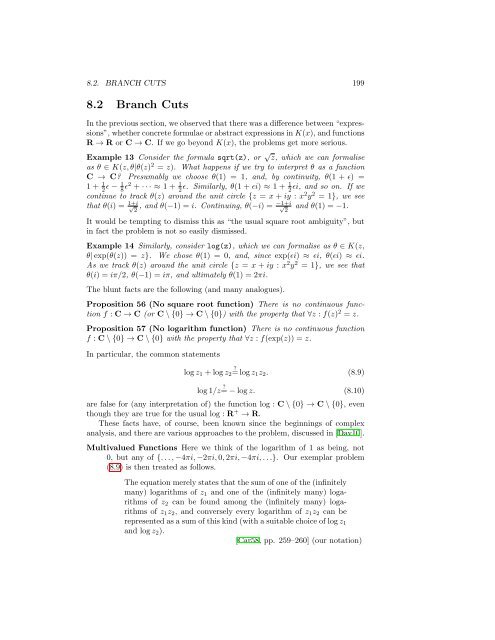Contents - Student subdomain for University of Bath
Contents - Student subdomain for University of Bath
Contents - Student subdomain for University of Bath
Create successful ePaper yourself
Turn your PDF publications into a flip-book with our unique Google optimized e-Paper software.
8.2. BRANCH CUTS 199<br />
8.2 Branch Cuts<br />
In the previous section, we observed that there was a difference between “expressions”,<br />
whether concrete <strong>for</strong>mulae or abstract expressions in K(x), and functions<br />
R → R or C → C. If we go beyond K(x), the problems get more serious.<br />
Example 13 Consider the <strong>for</strong>mula sqrt(z), or √ z, which we can <strong>for</strong>malise<br />
as θ ∈ K(z, θ|θ(z) 2 = z). What happens if we try to interpret θ as a function<br />
C → C? Presumably we choose θ(1) = 1, and, by continuity, θ(1 + ɛ) =<br />
1 + 1 2 ɛ − 1 8 ɛ2 + · · · ≈ 1 + 1 2 ɛ. Similarly, θ(1 + ɛi) ≈ 1 + 1 2ɛi, and so on. If we<br />
continue to track θ(z) around the unit circle {z = x + iy : x 2 y 2 = 1}, we see<br />
that θ(i) = 1+i √<br />
2<br />
, and θ(−1) = i. Continuing, θ(−i) = −1+i √<br />
2<br />
and θ(1) = −1.<br />
It would be tempting to dismiss this as “the usual square root ambiguity”, but<br />
in fact the problem is not so easily dismissed.<br />
Example 14 Similarly, consider log(z), which we can <strong>for</strong>malise as θ ∈ K(z,<br />
θ| exp(θ(z)) = z}. We chose θ(1) = 0, and, since exp(ɛi) ≈ ɛi, θ(ɛi) ≈ ɛi.<br />
As we track θ(z) around the unit circle {z = x + iy : x 2 y 2 = 1}, we see that<br />
θ(i) = iπ/2, θ(−1) = iπ, and ultimately θ(1) = 2πi.<br />
The blunt facts are the following (and many analogues).<br />
Proposition 56 (No square root function) There is no continuous function<br />
f : C → C (or C \ {0} → C \ {0}) with the property that ∀z : f(z) 2 = z.<br />
Proposition 57 (No logarithm function) There is no continuous function<br />
f : C \ {0} → C \ {0} with the property that ∀z : f(exp(z)) = z.<br />
In particular, the common statements<br />
log z 1 + log z 2<br />
?<br />
= log z1 z 2 . (8.9)<br />
log 1/z ? = − log z. (8.10)<br />
are false <strong>for</strong> (any interpretation <strong>of</strong>) the function log : C \ {0} → C \ {0}, even<br />
though they are true <strong>for</strong> the usual log : R + → R.<br />
These facts have, <strong>of</strong> course, been known since the beginnings <strong>of</strong> complex<br />
analysis, and there are various approaches to the problem, discussed in [Dav10].<br />
Multivalued Functions Here we think <strong>of</strong> the logarithm <strong>of</strong> 1 as being, not<br />
0, but any <strong>of</strong> {. . . , −4πi, −2πi, 0, 2πi, −4πi, . . .}. Our exemplar problem<br />
(8.9) is then treated as follows.<br />
The equation merely states that the sum <strong>of</strong> one <strong>of</strong> the (infinitely<br />
many) logarithms <strong>of</strong> z 1 and one <strong>of</strong> the (infinitely many) logarithms<br />
<strong>of</strong> z 2 can be found among the (infinitely many) logarithms<br />
<strong>of</strong> z 1 z 2 , and conversely every logarithm <strong>of</strong> z 1 z 2 can be<br />
represented as a sum <strong>of</strong> this kind (with a suitable choice <strong>of</strong> log z 1<br />
and log z 2 ).<br />
[Car58, pp. 259–260] (our notation)












![[Luyben] Process Mod.. - Student subdomain for University of Bath](https://img.yumpu.com/26471077/1/171x260/luyben-process-mod-student-subdomain-for-university-of-bath.jpg?quality=85)



